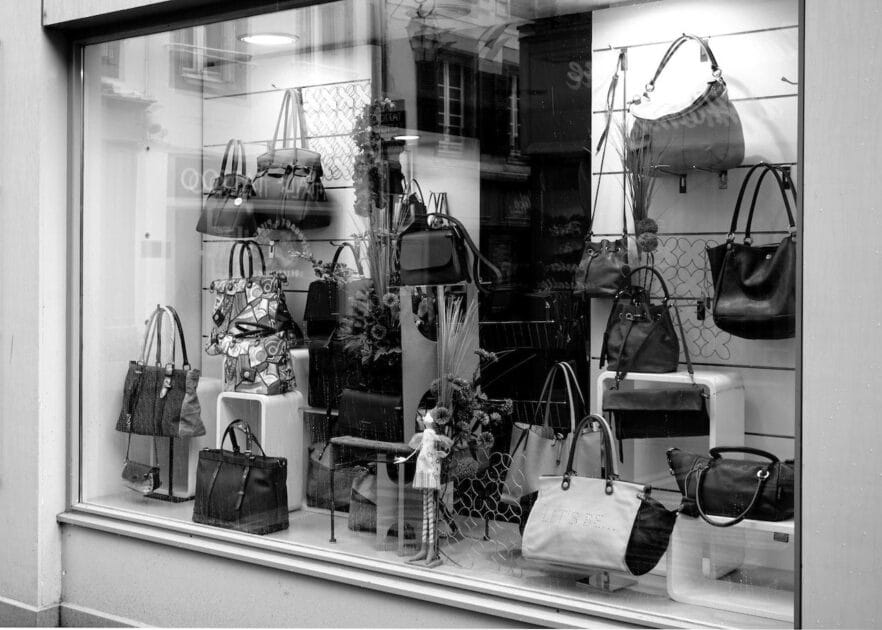Sprucing up your handbag with a scarf isn’t just a fashion statement—it’s a creative expression of your style! Whether you’re looking to add a pop of color or a touch of elegance, a scarf can transform your bag in seconds.
Step 1: Choosing the Right Scarf
When you’re ready to transform your handbag with a scarf, the first step is to select the perfect one. The material, size, and pattern of the scarf can make a huge difference in your bag’s overall look.
Fabric is critical. Opt for lightweight materials like silk, chiffon, or cotton. These fabrics tie smoothly and won’t damage delicate bag materials. Heavy fabrics can bulk up and distort the shape of your handbag.
Size matters too. For a small clutch, a narrow band or small square scarf keeps everything proportional. In contrast, oversized bags pair well with larger, more dramatic scarves. You’re aiming for balance so your scarf complements your bag without overwhelming it.
Pattern selection should mirror your personal style and the occasion. Solid colors offer versatility and are excellent for a chic, refined look. Go for bold patterns or bright hues if you want your bag to stand out. However, if your handbag already has a prominent design, consider a neutral or complementary color to avoid clashing.
And don’t forget seasonality. Light pastels and floral prints work well for spring, while rich, deeper colors suit the autumn and winter months.
Always keep in mind that the scarf you choose sends a message. It’s a reflection of your unique style and attitude towards fashion. So take a moment to consider what kind of statement you want to make whenever you step out with your handcrafted accessory in tow.
Step 2: Preparing Your Handbag
Before attaching a scarf, ensure your handbag is ready for a makeover. Begin by emptying it of all contents to avoid any bulging or misshaping which might distort the final look. You want a smooth canvas to work with, and an empty bag provides just that.
Next, give your handbag a quick clean. Use a suitable cleaner for the material, whether it’s leather conditioner for a leather bag or a damp cloth for canvas. This step will not only help the scarf to adhere better but also maintain the longevity of your handbag.
Inspect your handbag for any loose threads or hardware that might snag the scarf. If you find any, cautiously remove or tuck in the loose ends. Your handbag should be in the best possible condition to complement the chic look you’re aiming for.
Adjust the straps of the bag or remove them if possible. This will provide a clearer area to work with and prevent any interference as you drape or tie the scarf. Remember, strategies for applying the scarf could vary depending on your intended style.
Lastly, consider the placement where you’d like the scarf to accentuate your handbag. Common options include wrapping it around the handles or tying it in a bow for a decorative touch. Decide whether you prefer it to be a subtle hint of personality or a bold statement piece.
With your handbag prepped, you’re ready to progress. The next steps will delve into the actual techniques of attaching the scarf, ensuring that the end result is both stylish and secure.
Step 3: Tying the Scarf onto Your Handbag
Once you’ve prepped your handbag, it’s time to get creative with your scarf. Start by laying the scarf flat on a surface. Fold it diagonally to form a triangle if it’s square or simply pick it up from the center if it’s rectangular. You want a sleek line, not bulky folds.
Begin at the handle, wrapping the scarf tightly around it. If you’re going for a bow, leave one end slightly longer. For a double knot, strive for equal lengths. Here are a couple of popular styles:
- The Simple Knot: Just loop the scarf under the handle, cross the ends over and pull them tight. Slide the knot to your desired position—the side gives a casual feel while the front makes more of a statement.
- The Bow Tie: Perfect if you’ve left one end longer. Tie a single knot first, then make a loop with the longer end and wrap the shorter end around it to form a bow. Adjust until you’ve got that just-right bow shape.
Try the Twist Wrap for a change. Simply twist the scarf as you wrap it around the handle. It gives texture and a dash of elegance. Secure with a hidden knot underneath.
For an adjustable strap, weave the scarf through the links if they’re open enough. Think of it as threading a needle, moving over and under each link. When you’re done, a simple knot should do.
Keep the scarf’s fabric in mind. Silk slides easily and may need a tighter knot; cotton grips better. Always opt for a secure tie that won’t undo itself as you strut down the street.
You can also experiment with wrapping the scarf around the handbag’s body. Just make sure it doesn’t restrict access to your essentials.
« Hermès Handbags: The Pinnacle of Luxury Pricing – Find Out Why
Handbag Organization Hacks: Master How to Set Handbags for Daily Ease »
Remember to allow your style to shine through. Switch it up depending on your mood or outfit. The scarf is an accessory that’s all about personal expression.
Step 4: Experimenting with Different Styles
Once you’ve got the basics down, it’s time to play around with different scarf-tying techniques. Mix and match colors and patterns to make a statement. Here’s how to keep your style fresh:
- The Braided Look: Plait your scarf as you would braid hair and wrap it around the handle. It adds a textural element that’s both chic and unexpected.
- Layering: Combine two scarves of varying colors or prints. Start with the simple knot method for the base layer and then add the second scarf using the bow tie method for an eye-catching effect.
Remember, there’s no right or wrong way to style your scarf on a handbag. If one style doesn’t work for you, simply untie and try another. Patterns often look striking against solid-colored bags, while a monochrome scarf can add a touch of class to a patterned purse. The key is balance.
Don’t be afraid to let the tails of the scarf hang loose for a more relaxed vibe, or tuck them neatly away for a polished look. Length can play a role in how the scarf impacts your bag’s appearance. Longer scarves offer more versatility but require a secure tie so they don’t drag or catch.
Interchanging scarves also protects the handle of your handbag, especially if it’s made of delicate material like leather. Frequent changes not only keep your look fresh but also distribute wear evenly over time.
Keep in mind that the materials of both your scarf and handbag should complement each other. A silk scarf might slide off a leather bag, but it could grip well onto suede or canvas. Meanwhile, heavier materials like wool can stay put on smoother surfaces.
Step 5: Maintaining and Cleaning Your Scarf
To keep your handbag’s companion looking its best, it’s vital to maintain and clean your scarf properly. Silk scarfs, for instance, require gentle handling. It’s recommended to hand wash them in cold water with a mild detergent. After washing, lay them flat to dry, away from direct sunlight which can fade the colors.
For cotton or synthetic materials, you can be a bit more relaxed. Machine washing on a delicate cycle is usually safe. But be smart – always read the label first. Sometimes a scarf might look tough but will have specific cleaning instructions. Ignoring these could ruin your scarf’s texture and color.
Beware of snags. Scarves can catch on zippers, jewelry, and even the handbag itself. Check your scarf regularly for pulled threads or damage. If you find any, deal with them promptly. A small snag can become a big hole if not fixed immediately.
Storage is equally important. Don’t just toss your scarf in a drawer after use. Instead, fold it gently or use a scarf hanger. Proper storage prevents wrinkles and preserves the scarf’s shape, making it always ready for your next handbag enhancement.
If you’re dealing with stains – act fast! Blot, don’t rub, and use a stain remover suitable for the fabric type. For tougher stains on delicate scarves, consider taking them to a professional cleaner. This extra step can save your scarf from becoming permanently blemished.
Remember, scarves need care too, not just your handbag. By cleaning and maintaining your scarves, you ensure that they’ll always look as good as the day you bought them. Your handbag will thank you – and so will your style.
Conclusion
Wrapping up, remember that a well-maintained scarf can transform your handbag from simple to chic in a snap. By keeping your scarves clean, snag-free, and well-stored, you’ll ensure they’re ready to accentuate your look whenever you need. Don’t let a little stain put you off—tackle it quickly or seek professional help when needed. Now that you’ve got the know-how, go ahead and give your handbag a fresh twist with your favorite scarf. Happy styling!
Frequently Asked Questions
How should I wash a silk scarf?
For silk scarves, it’s best to hand wash them gently with a mild detergent and cool water, then lay them flat to dry away from direct sunlight.
Can I machine wash my cotton or synthetic scarf?
Yes, cotton and synthetic scarves can typically be machine washed. Use a gentle cycle with cool water and a mild detergent. Avoid tumble drying; instead, lay flat or hang to dry.
What should I do if I notice snags or damage on my scarf?
Regularly check your scarf for any signs of damage. If snags occur, gently repair them with a needle and thread if possible. Avoid wearing or storing the scarf in a way that could cause further damage.
What’s the best way to store my scarf?
Store your scarf by either rolling it loosely or hanging it to prevent wrinkles and preserve its shape. Avoid folding it sharply or placing heavy items on top of it.
How do I remove stains from my scarf?
Act quickly to treat stains by gently dabbing with a mild detergent or stain remover suitable for the scarf’s material. For delicate scarves with tough stains, consider getting a professional cleaning.











